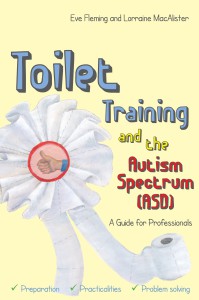 The authors of the book Toilet Training and the Autism Spectrum (ASD): A Guide for Professionals Eve Fleming and Lorraine MacAlister, share with us their top tips for practitioners training children with an ASD to appropriately use the toilet.
The authors of the book Toilet Training and the Autism Spectrum (ASD): A Guide for Professionals Eve Fleming and Lorraine MacAlister, share with us their top tips for practitioners training children with an ASD to appropriately use the toilet.
Learning to use the toilet is one of the most important life skills to teach a child with autism. It is necessary to create independence and allows opportunities for other activities, including those that help to develop socialisation. It is also important to remember that for older children it is never too late to start toilet training, or to address any problems with independent toilet skills that are occurring. So here are our top 5 things to consider as a professional working in this area with children on the spectrum.
1. Familiarise the child with the language of using the toilet
Preparation for helping children with autism learn to use the toilet is essential. One of the first things you should do is to familiarise the child with the correct vocabulary and steps to using the toilet safely. This includes learning the words for wee and poo, understanding what toilets are for and where the wee and poo should go. This can be done before starting formal toilet training and leaving off nappies. For children with delays in language and understanding, pictures, signs and objects may be used to help them understand and communicate.
2. Try to make the bathroom fun
For many children with autism, toilet training can be a challenge and may take some time. Families will need ongoing support through this process. Often children with autism have become comfortable with using a nappy, they may dislike the idea of change, feel uncomfortable in underwear and thus resist doing their wee and poo in the toilet. The result is that they find the toilet to be a frightening place to go to, this is not good for anyone. It is important to try your best to cultivate the bathroom environment as an area where they can enjoy themselves or at the very least not feel frightened. Think of it as a place where they can play with bathwater and perhaps the interesting smelling bathroom products and try to transmit that across to them while at the same time remembering the importance of the language you use to describe going to the toilet.
3. Get the timing just right
It is important to choose the right time to start learning to use the toilet. This needs to be best for the child and the family. Consideration may need to include careful thought about what things are impacting on the family. If there are changes occurring such as starting school or changing class it may good to let the child settle before starting to help them learn a new skill.
4. Don’t forget about the physical developments concerning bowel control
It is essential to consider the physical development of the bowel and bladder as well as that of the child’s autism spectrum condition. Problems with bladder control, especially immaturity of control, are common in all young children including those with autism. Difficulties such as constipation are also common, especially for children who have rigid diets, and for those who sometimes learn to hold on to their poo. These factors need to be assessed and treated, as problems with bladder and bowel control can create significant difficulties with toilet training.
5. Always ensure that you have broken down all the tasks clearly enough so that everyone is on the same page
Employing a step by step approach to developing the skills to use the toilet is undoubtedly the best way to learn, but it is crucial to ensure that everyone involved with this part of the child’s development is providing them with the same messages as well as using the same strategies. It is essential to make sure the parents, siblings, family members, carers and teachers are as clear as they need be about the targets you are setting and the methods being used to achieve them. This will ensure that learning is consistent and that the child becomes used to developing the skill in different settings.
If you found this blog useful why not sign up to the JKP Mailing List for access to more content like this and updates on our latest books in your area(s) of interest.
Eve Fleming and Lorraine MacAlister are the authors of Toilet Training and the Autism Spectrum (ASD): A Guide for Professionals which is now available from Jessica Kingsley Publishers